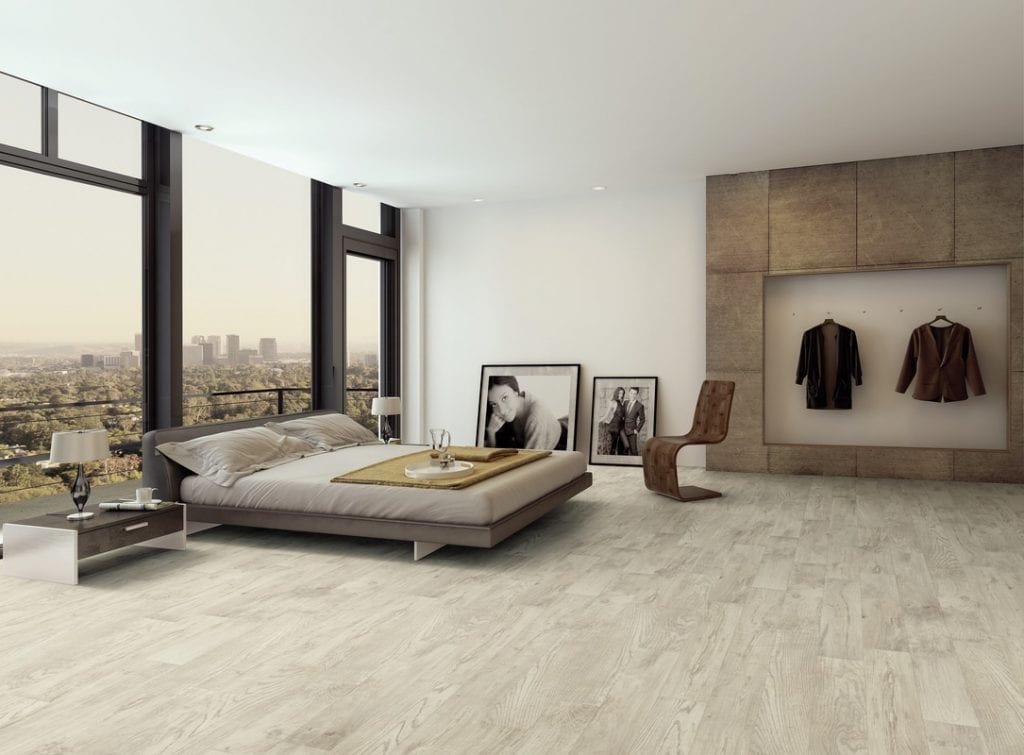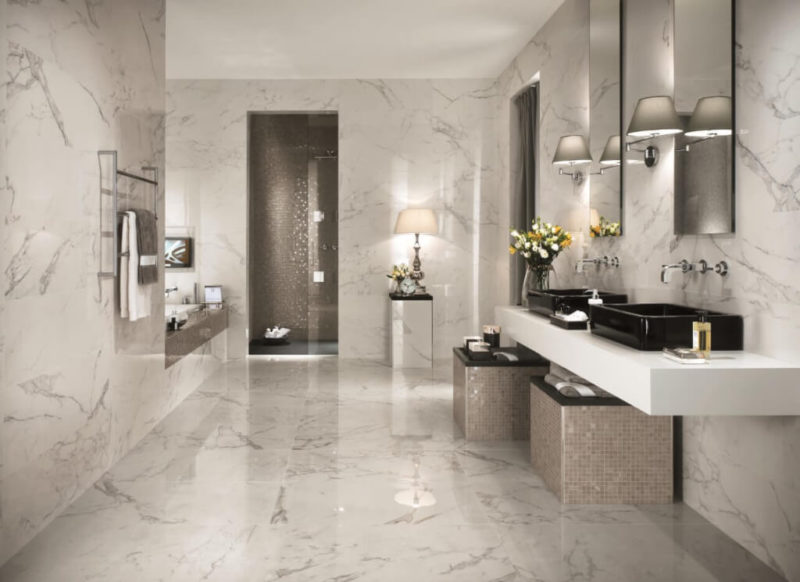Tile Terminology
Ceramic: A fired clay material. Click here to learn more about the development of ceramic on our blog.
Double-fired or Bicottura tiles: Double-fired or Bicottura tiles are glazed ceramic tiles produced by a procedure that breaks the firing process in two phases. An initial firing of the shaped raw materials produces a hard tile body or bisque and then a re-firing of the bisque takes place once the glaze or decoration has been applied. Usually, there are two glazes on the tile, first a non-transparent glaze on the body, then a transparent glaze on the surface. Double-fired tiles have sophisticated finishes with deeper shine and sharper colors.
Dust-pressed tiles: Dust pressed tiles are formed by the dust pressed method in which the finely grinded clay and raw materials are shaped in molds at high pressure before firing. Dry-pressed tiles are consistent with regard to their overall dimension. This method is also efficient and cost effective.
Extruded tile: Extruded tiles are formed by a process in which the wet clay or plastic raw material is forced through a mold and then cut into shape before firing. These tiles are less dimensionally consistent than pressed tiles. Extruded tiles include rustic styles such as terra cotta and clinker. These tiles are often used outside or where a rustic effect is wanted. Single extruded tiles are produced in a long slab, which is then cut to shape while double-extruded tiles, also known as split tiles, are produced in a column that must be split before tiles are cut.
Finish: This is the textural or visual characteristic of a tile surface. For glazed tile this may be bright or high gloss, satin or matte. Also, for both glazed and unglazed tiles, the finish can be flashed, textured, polished, raised, embossed, dimpled, etched, scored, ribbed etc.
Glaze: When tiles are decorated with natural and artificial colors through a second firing process.
Grout: Filling powder form in premixed colors used to fill the joints between tiles.
Impervious stoneware tile: Dust-pressed ceramic tiles with water absorption levels less than 0.5% are known as impervious stoneware tiles. They also have high mechanical and chemical characteristics. Also known as Fully Vitrified Stoneware or Porcelain Stoneware, these tiles are often recommended for exterior installations.
ISO: ISO is the abbreviation of International Standards Organization, a worldwide network of the national standards institutes of 157 countries. It has also drafted international standards (ISO/TC 189 “Ceramic Tiles”) for ceramic tiles. ISO Standards are used by tile manufacturers worldwide.
Joists: The boards in your home where the subfloor is attached. These represent the ” frame ” of the construction.
Mosaic tile: Small tiles connected in a pattern using a mesh backing that can either be used as an accent or as a full wall or floor.
Non-rectified, or standard, tiles: These are produced so that there are slight variations in tile size.
Pattern: A design engraved in outline on the surface of the tile, or carved in relief pressed into the tile.
PEI classes or ratings: Porcelain Enamel Institute rating scale which represents the amount of foot traffic that a tile can handle.
Porcelain: a specific type of ceramic that has unique features such as a high density and durability.
Rectified tile: Goes through a manufacturing process to assure each tile is exactly the same size and shape, and therefore it is possible to lay them cleanly and carefully with very little grout.
Saltillo tile: A porous tile in a range of tones of red which, while beautiful, should not be used in rooms that have a lot of water splashing, like the bathroom or kitchen.
Single-fired/Monocottura tiles: Monocottura is an Italian word meaning “single-fired”. In this method, individual tiles are shaped, glazed and fired in one step, at the same time. These tiles are also known as Monocottura tiles. They may be glazed or unglazed. Single-fired tiles are much stronger, with better glaze adhesion.
Subfloor: The primary layer of floor that is the base floor before any new floor is added. In a home, the plywood on the joists is the subfloor. In a commercial building, the cement is the subfloor.
Thin-set: The mortar used to adhere the tile to the sub-floor or under floor. Typically made of cement, fine sand and a water retaining agent.
Underlay: The material that can go between the final flooring surface and the subfloor. For tiles, the use of a cement backer board may be used as underlay to help the tile adhere properly to uneven our porous surfaces.
Adhesive – used for bonding tile to a surface.
Battiscopa – the Italian term for a bullnose trim piece.
Border – a strip of tile with design, texture or contrasting color that creates a design concept.
Breaking strength – the force needed to break a tile.
Brushed finish – a finish resulting from treating the stone surface with a coarse wire rotary brush.
Bullnose – a trim tile with a convex radius or finished edge on one side. Used for finishing top of wainscot, turning of an outside corner, or floor base.
Buttering or Back Buttering – The spreading of a bond coat on the back of a porcelain or ceramic tile immediately before the tile is installed.
Caulk – a soft, water resistant plastic material used for sealing joints.
Color Body Porcelain – porcelain tile in which the body of the tile is similar in color to the surface of the tile.
Cove – A trim tile with one edge a concave radius. Used to form a junction between the bottom wall course and the floor or to form an inside corner.
Cure – the time period that a tile installation setting material must be undisturbed and allowed to set for it to reach full strength.
Decorative tile – any tile face with a decoration on the surface.
Deep Abrasion Test – measures the resistance to abrasion of an unglazed tile.
Dry set mortar – cement based setting material for thin–bed installations.
Dynamic Coefficient of Friction (DCOF) – Slip resistance of a tile.
Epoxy adhesive – a two part adhesive system consisting of epoxy resin and epoxy hardener. Used for bonding ceramic tile or stone to backing material.
Epoxy grout – a two–part grout system consisting of epoxy resin and epoxy hardener. Made to have impervious qualities, stain and chemical resistant. Used to fill joints between tiles.
Field tile – the primary tile used to cover a wall or floor.
Floating – a method of aligning mortar with the float strips or screeds using a straightedge.
Floor tile – a ceramic tile or natural stone tile durable enough to withstand traffic and abrasion.
Frost resistant –Vitreous tile that absorbs .5% to 3%
Frost proof – impervious tile that absorbs 0% to 0.5%. Strongest tile for outdoor use.
Grout – silica sand, cement and chemical mix for filling tile joints. Available in a wide variety of colors.
Glazed tile – a tile that has an impervious facial finish composed of gaseous ceramic materials fused to the surface of the tile.
Granite – a natural stone more dense than marble. Granite is molten lava that never rose above the surface of the earth. It is extremely durable and holds a polish. Available in polished, honed or flamed (rough) surfaces.
Impervious tile – has water absorption of 0.5% or less.
Lappato – a semi-polished finish on the surface of the tile.
Levigato – a full-polish finish on the surface of the tile.
Limestone – sedimentary stone that could have fossils or shells. Usually comes with a honed (matte) finish. Not a wide variety of color; stones have little variety from piece to piece.
Listello – a decorative border, primarily for walls.
Marble – a natural stone product quarried from the earth. It gets a distinctive shine from the polishing process it goes through. Available in multiple finishes and a wide variety of colors.
Mastic – a ready to use organic glue.
Monocottura – method of producing tile by a single firing in which body and glazes are fired in kilns at temperatures over 2000 degrees.
Mosaics – ceramic, porcelain, glass, metal or stone tile mounted on mesh for ease of installation. May come in squares, octagons, hexagons or random shapes.
Mud – slang term referring to thick–bed mortar consisting of sand and cement.
PEI – classification of the resistance to abrasion of a glazed tile.
Porcelain tile – Characterized by a dense and impervious body generally made of the dust–pressed method.
Quarry tile – a slang term usually 6×6 impervious unglazed tile.
Sealer – a penetrate applied to prevent the absorption of liquids or other debris. Used with porous materials including: quarry tile, grout, and natural stone. Sealer is not necessary for glazed ceramic tile.
Slate – a natural material that is known for its dynamic colors and “earthy” appeal. Colors range from grey to purple to black. Slate is used outside as well as inside because of its natural look and wonderful colors.
Spacers – plastic pieces that are used in installation to evenly separate tile. Manufactured in various thicknesses and shapes.
Substrate – the underlayment for the ceramic tile installation.
Thin–set – term used to describe the bond coat in a thin bed installation. It is made of sand, cement and usually a latex additive.
Through Body Porcelain – porcelain tile in which the pattern on the surface of the tile goes through the body of the tile.
Tile – a ceramic unit, usually thin in relation to facial area. Made from clay or a mixture of clay and other ceramic material. Has a glazed or an unglazed face.
Travertine – similar composition to limestone but with holes created by hot springs. Colors include beige, red, yellow and brown, with some variation from piece to piece.
Trim pieces – various shaped of bases, caps, corners, moldings, angles, etc.
Tumbled – a finish achieved by placing stone tiles in a tumbling machine, sometimes with the addition of acids, to soften the edges and give the surface a worn look.
Unglazed tile – a hard, dense tile of uniform composition. No glaze.
Vitreous tile – has water absorption of more than 0.5%, but not more than 3%.
Wall tile – glazed tile with a body suitable for interior use. Not expected to withstand excessive impact or be subject to freezing/thawing conditions. It is not appropriate for use on the floor.


